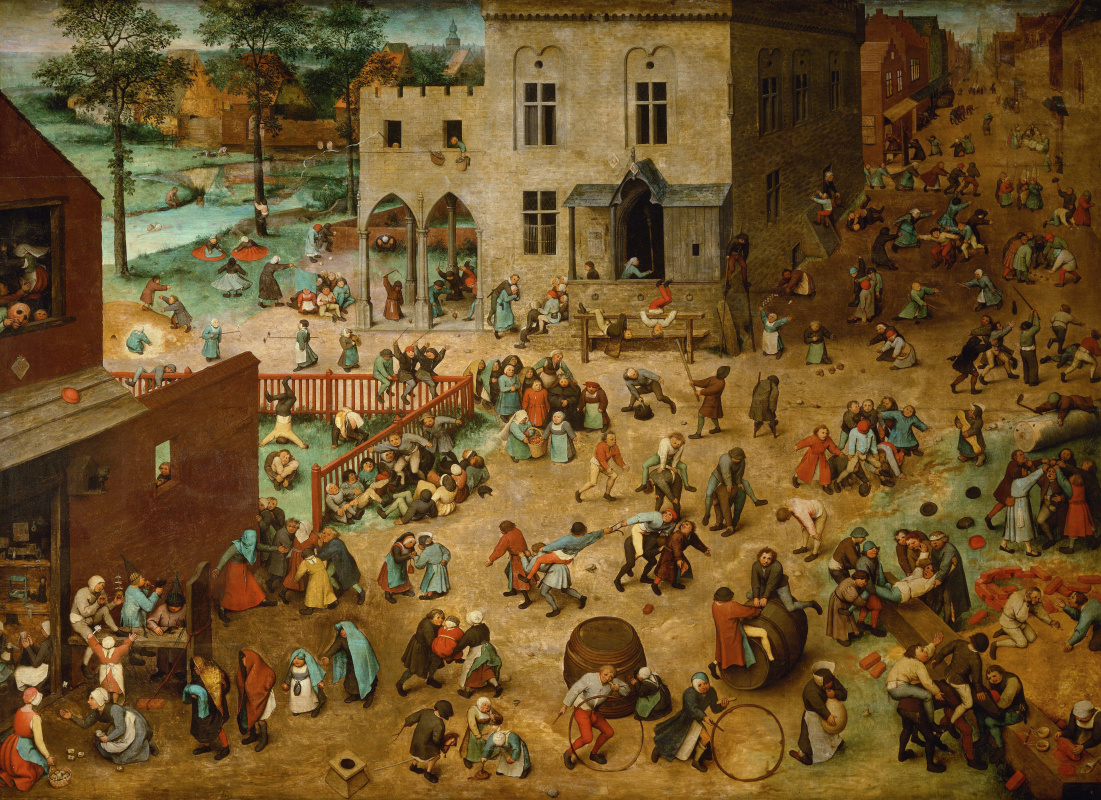log in
Enter site
Login to use Arthive functionality to the maximum
Kids games
Pieter Bruegel The Elder • Painting, 1560, 118×161 cm
Description of the artwork «Kids games»
An early painting by Pieter Bruegel the Elder "Children's games" not be called grandiose in size: its dimensions are 118 to 161 centimeters. However, in this relatively small space to accommodate a huge number of various figures, which even count (not to mention the fact, to figure out what everyone is doing) is a serious problem.
Some researchers believe that the number of characters in "kids Games" – a little more than 230 years. Others believe, given some of the most remote tiny figurines and those that are only partially visible in the Windows and doorways, we should talk about 250 characters. While they are "active" in the most literal sense: they are extremely absorbed in their occupations, and their games are almost never repeated.
Someone is standing on his head, somebody's got to saddle fellow and rides at full speed someone to ride on the barrel, someone playing with hoops, someone rolls the dice, someone's playing a mother-daughter or in the wedding... Given the large number of characters, only listing their games and the business would occupy more than one page. By the way, Bruegel is painting, written in the same period as "children" and also oriented to the folk woodcut prints, which made the whole table, and directory specifying the occupations of the characters. It's called "Netherlandish Proverbs"and the encrypted at least 118 Proverbs and idiomatic expressions (a few Proverbs from the painting described in the last Chapter this material).
Experts believe that the only adult character in "kids Games" is a woman pour water two locked in a fight boys. However, to see her coming out of the side door of the house in the background (by the way, the architecture of the house is pure Dutch, but it somehow added light Italian loggia), it will need a serious visual stress. Or a magnifying glass.
And yet, although depicted children, Bruegel appears to be, metaphorically tells us about the world of adults, their activities, which are often meaningless or even cruel, like many children's games in the picture. Bruegel is not alien here moralizing. Besides it, according to some experts, is here under the influence of the writings of his fellow countryman Erasmus of Rotterdam's "Praise of folly" who dared to see the world from the point of view of the qualities of "all times and all peoples" – nonsense. "There is nothing sillier than serious perception of playfulness– says Erasmus. – But also there is nothing more meaningless than playfulness in serious matters".
There is a "kids Games" allusion and the school of Brueghel. The girl in the lower right corner crushes red bricks. So do artists: the powder obtained can be converted into a pigment for paints.
Author: Anna Yesterday
Some researchers believe that the number of characters in "kids Games" – a little more than 230 years. Others believe, given some of the most remote tiny figurines and those that are only partially visible in the Windows and doorways, we should talk about 250 characters. While they are "active" in the most literal sense: they are extremely absorbed in their occupations, and their games are almost never repeated.
Someone is standing on his head, somebody's got to saddle fellow and rides at full speed someone to ride on the barrel, someone playing with hoops, someone rolls the dice, someone's playing a mother-daughter or in the wedding... Given the large number of characters, only listing their games and the business would occupy more than one page. By the way, Bruegel is painting, written in the same period as "children" and also oriented to the folk woodcut prints, which made the whole table, and directory specifying the occupations of the characters. It's called "Netherlandish Proverbs"and the encrypted at least 118 Proverbs and idiomatic expressions (a few Proverbs from the painting described in the last Chapter this material).
Experts believe that the only adult character in "kids Games" is a woman pour water two locked in a fight boys. However, to see her coming out of the side door of the house in the background (by the way, the architecture of the house is pure Dutch, but it somehow added light Italian loggia), it will need a serious visual stress. Or a magnifying glass.
And yet, although depicted children, Bruegel appears to be, metaphorically tells us about the world of adults, their activities, which are often meaningless or even cruel, like many children's games in the picture. Bruegel is not alien here moralizing. Besides it, according to some experts, is here under the influence of the writings of his fellow countryman Erasmus of Rotterdam's "Praise of folly" who dared to see the world from the point of view of the qualities of "all times and all peoples" – nonsense. "There is nothing sillier than serious perception of playfulness– says Erasmus. – But also there is nothing more meaningless than playfulness in serious matters".
There is a "kids Games" allusion and the school of Brueghel. The girl in the lower right corner crushes red bricks. So do artists: the powder obtained can be converted into a pigment for paints.
Author: Anna Yesterday


